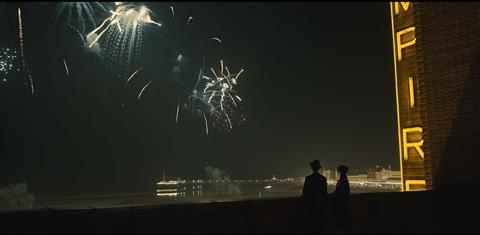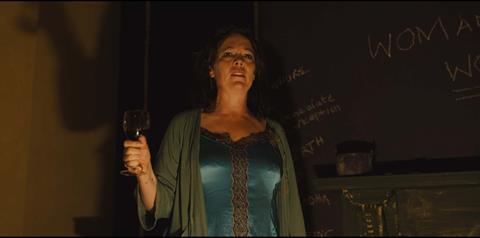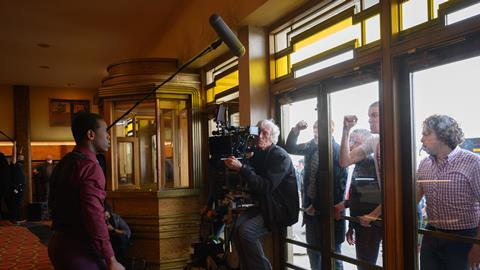For Sam Mendes’s most personal film to date and his love letter to cinema, there was only one person to shoot Empire Of Light. Screen meets celebrated cinematographer and Mendes’s longtime collaborator, Roger Deakins
When Roger Deakins meets Screen International in January, he has just received a Bafta nomination for his work on Sam Mendes’s personal drama Empire Of Light. It is the veteran cinematographer’s 11th from the British Academy, five of which have yielded an award — including his last film with Mendes, 1917 — so he should not be surprised.
Deakins is, after all, the most decorated director of photography in Bafta history, as well as a two-time Oscar winner and 16-time nominee, his latest also coming for Empire Of Light. From The Shawshank Redemption to Blade Runner 2049, it is easy to argue the case for Deakins being the greatest living cinematographer. Yet, he admits, he was not expecting this latest accolade. “It’s kind of a surprise but I’ll take it. Empire Of Light is a small film and quite reserved. But it’s nice people noticed something.”
Empire Of Light, the filmmaking pair’s fifth collaboration, is not as showy as their First World War movie 1917, presented to viewers as a single continuous shot. But it has a different, deeper kind of power, focusing on a love affair between two employees at a cinema, the titular Empire, on the southeast coast of England during the 1980s: Hilary (Olivia Colman), a woman Mendes based on his own mother, who lived with mental health issues; and Stephen (Micheal Ward, also Bafta nominated), a young Black man coming of age amid the rise of the racist, right-wing National Front.
“I thought the script was great,” says Deakins, who grew up on England’s south coast, in Torquay, Devon. “It’s obviously very personal to Sam. But I liked the characters. I’m always drawn to a film if I find the characters interesting.”
Early on, he and Mendes discussed doing the whole movie handheld, then considered shooting in black and white. Eventually, they settled on a visual approach that would prioritise intimacy. “We ended up saying, ‘Why are we moving the camera? Let’s do it in a much more Bressonian way, where the camera’s not drawing attention to itself at all. It’s really observing the characters.’”
Here, Deakins talks through four key moments for those characters, each of which required its own distinct approach. Spoilers follow.
New Year’s Eve fireworks
The scene: Hilary and Stephen see in the New Year on the roof of the Empire, where they share their first kiss as the fireworks spark and cascade in the night sky.

Roger Deakins: “In Margate we found Dreamland, this big old Art Deco cinema that we turned into the Empire. Part of its attraction was the exterior, and it had an old ballroom that we used as well. But it also had a roof that was in quite a good position. What wasn’t in the script, but which the roof gave us, was the view of the tower block. We said, ‘Stephen could live up there!’ It was perfect.
“We could have done the fireworks in CG, on stage. Which wouldn’t have meant doing a night shoot in February or March in Margate. But Sam and I wanted to shoot as much as possible on location and feel the reality of it.
“However, it was a tricky one. We had to put festoon lights along the seafront. We had to get the fireworks on the beach. We had to get the right-size fireworks, and enough of them to do an open number of takes. We had to do it on the right day, so it wasn’t too windy. I had to get a certain amount of smoke in the air from the special-effects guy, Richard [Cheal], because I needed to backlight a very light haze to silhouette the characters against the beach and the fireworks beyond. And we had to put lights on the pier. And light the tower block.
“We also had to light Stephen and Hilary as they’re drinking their Babycham. So our production designer Mark Tildesley constructed a skylight and plumped it on the roof, as though it was above the lobby, which geographically wasn’t far off.
“All these little things had to come together. It seems simple when you think, ‘Let’s do it for real on the roof.’ But it wasn’t a big production, and money was limited. So you kind of work it out.”
The film premiere
The scene: Empire manager Don Ellis (Colin Firth) has arranged for the regional premiere of Chariots Of Fire to take place at the cinema. But his moment of triumph is ruined when Hilary, now off her medication, takes the stage to extol racial harmony, and then, during a dramatic confrontation in the lobby, reveals to Ellis’s wife (Sara Stewart) that he has been taking advantage of her, sexually.

DEAKINS: “The interior of the cinema was a difficult one. We had scouted everywhere, and we discussed building it, but that would have meant being on stage somewhere outside of Margate. Inside Dreamland there were a number of theatres, but they’d all been split. There wasn’t one big one. So we had to compromise.
“The theatre we shot in had been turned into a bingo hall, and its circle had been converted into another theatre. So it was a huge job to turn it into this ornate theatre, and difficult to light because of its drop ceiling, where the circle used to be. We had to create big rings of LED bulbs, and it was a lot of work to rig those.
“The lobby, meanwhile, is a built set; it doesn’t exist in Dreamland. We were very lucky that there was an empty lot, three doors away. So we built this set, which gave us the same view out to the promenade and the sea beyond. The stairway was designed with this scene in mind. Although originally the wife was going to storm down the stairs and the whole thing was going to happen on the floor. But in rehearsing it, it seemed better to keep some separation and have her looking down at Hilary and Ellis. It was much more dynamic.”
Hilary’s breakdown
The scene: On visiting Hilary’s flat, Stephen finds her having a manic episode, during which she delivers a harshly up-lit monologue on the toxic relationships in her life, as her own shadow looms behind her forebodingly.

DEAKINS: “This was an emotional moment for Sam, because, like Hilary, his mother was taken away on a number of occasions. But we talked through it, even before preproduction, [about] how it should feel and be staged. Sam said, ‘It would be nice to have something more unexpected,’ and I said, ‘Why don’t we have a bare-bulb lamp on the table?’ It was as simple as that.
“The scene is a bit gothic. I wanted Hilary to bleach out [as she leans towards the light]. But it’s a danger to go too over the top. It’s not The Cabinet Of Dr. Caligari, is it? It’s not that kind of extreme. Even so, this was a good place to have something more… noirish.
“But it’s funny about the shadow. I always thought the wall was painted too dark. The idea was Hilary had painted the wall and put graffiti on it, but I didn’t feel the shadow was as prominent as it could have been.
“With cinematography, sometimes you want to heighten what’s going on, sometimes you want to play it down, visually. This was definitely a case where we thought, ‘Let’s go for it.’ Maybe it’s better that the shadow on the wall is not as dramatic as it would have been on a white wall.”
The skinhead attack
The scene: During a ‘welcome back’ celebration for the now-recovered Hilary, the Empire staff witness a far-right procession on the promenade outside. Viewed entirely from inside the lobby, the party soon turns sour as a group of National Front skinheads spot Stephen, smash their way into the foyer, and beat him viciously.

DEAKINS: “If we had created the lobby as a set on stage and done the background as green screen, this scene would have been more controllable. But it wouldn’t have had the same sense of reality. So that drew us to building the set on location.
“We talked about doing it a lot of different ways — handheld or whatever. But it wouldn’t have worked as a single take. During the whole film, the perspective changes from Stephen’s to Hilary’s and back again. So, for a certain amount of the scene, you’re with Stephen. When the skinheads hit the glass and start breaking in, you’re very much with Stephen. But when he’s being beaten on the floor, you’re very much with Hilary.
“I think the whole one-shot thing is a bit overused. We had a very particular reason for doing that in 1917, which was a linear piece of narrative. There’s nothing wrong with cuts, you know. Besides, we wouldn’t have had the extras for it. Each shot had to be timed, and then they had to go back and change around, so some of the guys on scooters walked, and some of the guys walking got on scooters.
“We did do one exterior shot, with the bikes in the foreground — though I don’t think either Sam or I really wanted to shoot it. We thought, ‘What the hell’s that for?’ It didn’t make any sense. Or maybe we didn’t even shoot it. Maybe we just went out there and looked at it, or something. But it’s certainly not in the film, thankfully.”

























No comments yet